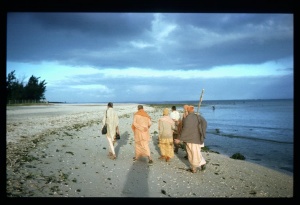CC Antya 1.137 (1975): Difference between revisions
(Vanibot #0027: CCMirror - Mirror CC's 1996 edition to form a basis for 1975) |
(Vanibot #0020: VersionCompareLinker - added a link to the Version Compare feature) |
||
| Line 2: | Line 2: | ||
<div style="float:left">'''[[Sri Caitanya-caritamrta (1975)|Śrī Caitanya-caritāmṛta (1975)]] - [[CC Antya (1975)|Antya-līlā]] - [[CC Antya 1 (1975)|Chapter 1: Śrīla Rūpa Gosvāmī's Second Meeting With the Lord]]'''</div> | <div style="float:left">'''[[Sri Caitanya-caritamrta (1975)|Śrī Caitanya-caritāmṛta (1975)]] - [[CC Antya (1975)|Antya-līlā]] - [[CC Antya 1 (1975)|Chapter 1: Śrīla Rūpa Gosvāmī's Second Meeting With the Lord]]'''</div> | ||
<div style="float:right">[[File:Go-previous.png|link=CC Antya 1.136 (1975)|Antya-līlā 1.136]] '''[[CC Antya 1.136 (1975)|Antya-līlā 1.136]] - [[CC Antya 1.138 (1975)|Antya-līlā 1.138]]''' [[File:Go-next.png|link=CC Antya 1.138 (1975)|Antya-līlā 1.138]]</div> | <div style="float:right">[[File:Go-previous.png|link=CC Antya 1.136 (1975)|Antya-līlā 1.136]] '''[[CC Antya 1.136 (1975)|Antya-līlā 1.136]] - [[CC Antya 1.138 (1975)|Antya-līlā 1.138]]''' [[File:Go-next.png|link=CC Antya 1.138 (1975)|Antya-līlā 1.138]]</div> | ||
{{CompareVersions|CC|Antya 1.137|CC 1975|CC 1996}} | |||
{{RandomImage}} | {{RandomImage}} | ||
==== TEXT 137 ==== | ==== TEXT 137 ==== | ||
<div class="verse"> | <div class="verse"> | ||
:rāya kahe, | :rāya kahe,--"prarocanādi kaha dekhi, śuni?" | ||
:rūpa kahe, | :rūpa kahe,--"mahāprabhura śravaṇecchā jāni" | ||
</div> | </div> | ||
| Line 18: | Line 17: | ||
<div class="synonyms"> | <div class="synonyms"> | ||
rāya kahe—Śrīla Rāmānanda Rāya says; prarocanādi kaha—please recite the prarocanā; dekhi—I shall see; śuni—and hear; rūpa kahe—Śrīla Rūpa Gosāñi replies; mahāprabhura—of Śrī Caitanya Mahāprabhu; śravaṇa- | rāya kahe—Śrīla Rāmānanda Rāya says; prarocanādi kaha—please recite the prarocanā; dekhi—I shall see; śuni—and hear; rūpa kahe—Śrīla Rūpa Gosāñi replies; mahāprabhura—of Śrī Caitanya Mahāprabhu; śravaṇa-icchā—desired to hear; jāni—I think. | ||
</div> | </div> | ||
| Line 25: | Line 24: | ||
<div class="translation"> | <div class="translation"> | ||
Rāmānanda Rāya said, | Rāmānanda Rāya said, "Please recite the prarocanā portion so that I may hear and examine it." Śrī Rūpa replied, "I think that the desire to hear of Śrī Caitanya Mahāprabhu is prarocanā. | ||
Śrī Rūpa replied, | |||
</div> | </div> | ||
| Line 35: | Line 33: | ||
The method of inducing the audience to become more and more eager to hear by praising the time and place, the hero and the audience is called prarocanā. This is the statement regarding prarocanā in the Nāṭaka-candrikā: | The method of inducing the audience to become more and more eager to hear by praising the time and place, the hero and the audience is called prarocanā. This is the statement regarding prarocanā in the Nāṭaka-candrikā: | ||
deśa-kāla-kathā-vastu- | |||
:sabhyādīnāṁ praśaṁsayā | |||
: | :śrotṝṇām unmukhī-kāraḥ | ||
:kathiteyaṁ prarocanā | |||
Similarly the Sāhitya-darpaṇa (6.286) says: | |||
Similarly | :tasyāḥ prarocanā vīthī | ||
:tathā prahasanā-mukhe | |||
aṅgānyatronmukhī-kāraḥ | |||
:tasyāḥ prarocanā vīthī tathā prahasanā-mukhe | :praśaṁsātaḥ prarocanā | ||
Any literature presented in Sanskrit must follow the rules and regulations mentioned in the authoritative reference books. The technical inquiries by Śrīla Rāmānanda Rāya and the replies of Śrīla Rūpa Gosvāmī indicate that both of them were expert and fully conversant with the techniques of writing drama. | Any literature presented in Sanskrit must follow the rules and regulations mentioned in the authoritative reference books. The technical inquiries by Śrīla Rāmānanda Rāya and the replies of Śrīla Rūpa Gosvāmī indicate that both of them were expert and fully conversant with the techniques of writing drama. | ||
</div> | </div> | ||
Latest revision as of 20:08, 26 January 2020

A.C. Bhaktivedanta Swami Prabhupada
TEXT 137
- rāya kahe,--"prarocanādi kaha dekhi, śuni?"
- rūpa kahe,--"mahāprabhura śravaṇecchā jāni"
SYNONYMS
rāya kahe—Śrīla Rāmānanda Rāya says; prarocanādi kaha—please recite the prarocanā; dekhi—I shall see; śuni—and hear; rūpa kahe—Śrīla Rūpa Gosāñi replies; mahāprabhura—of Śrī Caitanya Mahāprabhu; śravaṇa-icchā—desired to hear; jāni—I think.
TRANSLATION
Rāmānanda Rāya said, "Please recite the prarocanā portion so that I may hear and examine it." Śrī Rūpa replied, "I think that the desire to hear of Śrī Caitanya Mahāprabhu is prarocanā.
PURPORT
The method of inducing the audience to become more and more eager to hear by praising the time and place, the hero and the audience is called prarocanā. This is the statement regarding prarocanā in the Nāṭaka-candrikā:
deśa-kāla-kathā-vastu-
- sabhyādīnāṁ praśaṁsayā
- śrotṝṇām unmukhī-kāraḥ
- kathiteyaṁ prarocanā
Similarly the Sāhitya-darpaṇa (6.286) says:
- tasyāḥ prarocanā vīthī
- tathā prahasanā-mukhe
aṅgānyatronmukhī-kāraḥ
- praśaṁsātaḥ prarocanā
Any literature presented in Sanskrit must follow the rules and regulations mentioned in the authoritative reference books. The technical inquiries by Śrīla Rāmānanda Rāya and the replies of Śrīla Rūpa Gosvāmī indicate that both of them were expert and fully conversant with the techniques of writing drama.